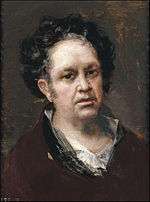Los disparates
_-_No._13_-_Modo_de_volar.jpg)
Los disparates (The Follies), also known as Proverbios (Proverbs) or Sueños (Dreams) is a series of prints in aquatint and etching, with retouching in drypoint and burin, created by Spanish painter and printmaker Francisco Goya between 1815 and 1823. Goya created the series while he lived in his house near Manzanares (Quinta del Sordo) on the walls of which he painted the famous Black Paintings. When he left to France and moved in Bordeaux in 1824, he left these works in Madrid apparently incomplete.[2] During Goya's lifetime, the series was not published because of the oppressive political climate and of the Inquisition. The disparates series was first published by the Royal Academy of Fine Arts of San Fernando in 1864 under the title Proverbios (Proverbs). In this edition, the titles given to the works are Spanish proverbs. On proofs of many plates there are titles handwritten by Goya, which include the word Disparate (Folly).[3] The series is an enigmatic album of 22 prints (in the first place 18 - 4 works were added later) which is the last major series of prints by Goya, which the artist created during the last years of his life. The scenes of the Disparates, which are difficult to explain, include dark, dream-like scenes that scholars have related to political issues, traditional proverbs and the Spanish carnival.[4]
The works of the series
The prints of the plates that are displayed below were published in 1864 (first publishment) and are part of the collection of Museo Nacional del Prado.[a 1]
_-_No._01_-_Disparate_femenino.jpg) Νο. 1: Disparate femenino (Feminine folly), 24,3 x 35,3 cm. (platemark)/33,6 x 50,3 cm. (sheet)
Νο. 1: Disparate femenino (Feminine folly), 24,3 x 35,3 cm. (platemark)/33,6 x 50,3 cm. (sheet)_-_No._02_-_Disparate_de_miedo.jpg) Νο. 2: Disparate de miedo (Fearful folly), 24,4 x 35,3 cm. (platemark)/33,7 x 50,2 cm. (sheet)
Νο. 2: Disparate de miedo (Fearful folly), 24,4 x 35,3 cm. (platemark)/33,7 x 50,2 cm. (sheet)_-_No._03_-_Disparate_rid%C3%ADculo.jpg) Νο. 3: Disparate ridiculo (Ridiculous folly), 24,5 x 35,3 cm. (platemark)/33,7 x 50,3 cm. (sheet)
Νο. 3: Disparate ridiculo (Ridiculous folly), 24,5 x 35,3 cm. (platemark)/33,7 x 50,3 cm. (sheet)_-_No._04_-_Bobalic%C3%B3n.jpg) Νο. 4: Bobalicón (Simpleton's folly), 24,3 x 35,2 cm. (platemark)/33,7 x 50,2 cm. (sheet)
Νο. 4: Bobalicón (Simpleton's folly), 24,3 x 35,2 cm. (platemark)/33,7 x 50,2 cm. (sheet)_-_No._05_-_Disparate_volante.jpg) Νο. 5: Disparate volante (Flying folly), 24,4 x 35,2 cm. (platemark)/33,7 x 50,2 cm. (sheet)
Νο. 5: Disparate volante (Flying folly), 24,4 x 35,2 cm. (platemark)/33,7 x 50,2 cm. (sheet)_-_No._06_-_Disparate_cruel.jpg) Νο. 6: Disparate furioso (Furious folly), 24,3 x 35,1 cm. (platemark)/33,6 x 50,2 cm. (sheet)
Νο. 6: Disparate furioso (Furious folly), 24,3 x 35,1 cm. (platemark)/33,6 x 50,2 cm. (sheet)_-_No._07_-_Disparate_desordenado.jpg) Νο. 7: Disparate matrimonial (Matrimonial folly), 24,4 x 35,2 cm. (platemark)/33,7 x 50,2 cm. (sheet)
Νο. 7: Disparate matrimonial (Matrimonial folly), 24,4 x 35,2 cm. (platemark)/33,7 x 50,2 cm. (sheet)_-_No._08_-_Los_ensacados.jpg) Νο. 8: Los ensacados (Folly in sacks), 24,4 x 35,1 cm. (platemark)/33,7 x 50,2 cm. (sheet)
Νο. 8: Los ensacados (Folly in sacks), 24,4 x 35,1 cm. (platemark)/33,7 x 50,2 cm. (sheet)_-_No._09_-_Disparate_general.jpg) Νο. 9: Disparate general (General folly), 24,1 x 35,1 cm. (platemark)/33,7 x 50,2 cm. (sheet)
Νο. 9: Disparate general (General folly), 24,1 x 35,1 cm. (platemark)/33,7 x 50,2 cm. (sheet)_-_No._10_-_El_caballo_raptor.jpg) Νο. 10: El caballo raptor (Kidnapping horse), 24,4 x 35,3 cm. (platemark)/33,7 x 50,2 cm. (sheet)
Νο. 10: El caballo raptor (Kidnapping horse), 24,4 x 35,3 cm. (platemark)/33,7 x 50,2 cm. (sheet)_-_No._11_-_Disparate_pobre.jpg) Νο. 11: Disparate pobre (Poor folly), 24,4 x 35,2 cm. (platemark)/33,7 x 50,2 cm. (sheet)
Νο. 11: Disparate pobre (Poor folly), 24,4 x 35,2 cm. (platemark)/33,7 x 50,2 cm. (sheet)_-_No._12_-_Disparate_alegre.jpg) Νο. 12: Disparate alegre (Merry folly), 24,3 x 35,2 cm. (platemark)/33,7 x 50,2 cm. (sheet)
Νο. 12: Disparate alegre (Merry folly), 24,3 x 35,2 cm. (platemark)/33,7 x 50,2 cm. (sheet)_-_No._13_-_Modo_de_volar.jpg) Νο. 13: Modo de volar (A way of flying), 24,4 x 35,3 cm. (platemark)/33,7 x 50,2 cm. (sheet)
Νο. 13: Modo de volar (A way of flying), 24,4 x 35,3 cm. (platemark)/33,7 x 50,2 cm. (sheet)_-_No._14_-_Disparate_de_carnaval.jpg) Νο. 14: Disparate de carnaval (Carnaval folly), 24,2 x 35,2 cm. (platemark)/33,7 x 50,2 cm. (sheet)
Νο. 14: Disparate de carnaval (Carnaval folly), 24,2 x 35,2 cm. (platemark)/33,7 x 50,2 cm. (sheet)_-_No._15_-_Disparate_claro.jpg) Νο. 15: Disparate claro (Clear folly), 24,3 x 35,2 cm. (platemark)/33,7 x 50,2 cm. (sheet)
Νο. 15: Disparate claro (Clear folly), 24,3 x 35,2 cm. (platemark)/33,7 x 50,2 cm. (sheet)_-_No._16_-_Las_exhortaciones.jpg) Νο. 16: Las exhortaciones (Clear folly), 24,4 x 35,3 cm. (platemark)/33,7 x 50,2 cm. (sheet)
Νο. 16: Las exhortaciones (Clear folly), 24,4 x 35,3 cm. (platemark)/33,7 x 50,2 cm. (sheet)_-_No._17_-_La_lealtad.jpg) Νο. 17: La lealtad (Loyalty), 24,4 x 35,1 cm. (platemark)/ 33,7 x 50,2 cm. (sheet)
Νο. 17: La lealtad (Loyalty), 24,4 x 35,1 cm. (platemark)/ 33,7 x 50,2 cm. (sheet)_-_No._18_-_Disparate_f%C3%BAnebre.jpg) Νο. 18: Disparate fúnebre (Funereal folly), 24,3 x 35,2 cm. (platemark)/33,7 x 50,3 cm. (sheet)
Νο. 18: Disparate fúnebre (Funereal folly), 24,3 x 35,2 cm. (platemark)/33,7 x 50,3 cm. (sheet)
The 4 works which were added later
_-_Disparate_de_toritos_(Disparate_de_tontos).jpg) Disparate de tontos, 24,3 x 35,5 cm. (platemark)/30,6 x 44,5 cm. (sheet)
Disparate de tontos, 24,3 x 35,5 cm. (platemark)/30,6 x 44,5 cm. (sheet)_-_Disparate_de_bestia.jpg) Disparate de bestia, 24,3 x 35,5 cm. (platemark)/30 x 42,8 cm. (sheet)
Disparate de bestia, 24,3 x 35,5 cm. (platemark)/30 x 42,8 cm. (sheet)_-_Disparate_conocido.jpg) Disparate conocido, 24,2 x 35,6 cm. (platemark)/30,1 x 44,1 cm. (sheet)
Disparate conocido, 24,2 x 35,6 cm. (platemark)/30,1 x 44,1 cm. (sheet)_-_Disparate_puntual.jpg) Disparate puntual, 24,6 x 35,6 cm. (platemark)/30,2 x 43,8 cm. (sheet)
Disparate puntual, 24,6 x 35,6 cm. (platemark)/30,2 x 43,8 cm. (sheet)
Notes
- ↑ The images are available on the website of the museum which is the source of the dimensions and the Spanish titles of the works mentioned in this article. The source of the English titles is goya.unizar.es.
References
- ↑ Hughes (1990), 63
- ↑ Wilson-Bareau, 77–78
- ↑ Southbank Centre, GOYA: THE DISPARATES
- ↑ The University of Arizona Museum of Art
Further reading
- Goya in the Metropolitan Museum of Art. New York: The Metropolitan Museum of Art. 1995. ISBN 9780870997525.
